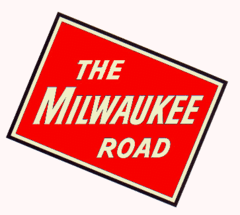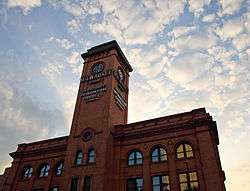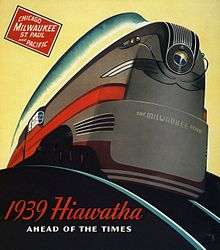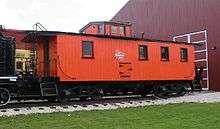Chicago, Milwaukee, St. Paul and Pacific Railroad
 | |
|
Milwaukee Road system map | |
| Reporting mark | MILW |
|---|---|
| Locale |
Idaho Illinois Indiana Iowa Kentucky Michigan Minnesota Missouri Montana Nebraska North Dakota South Dakota Washington Wisconsin |
| Dates of operation | 1851–1986 |
| Successor | Soo Line Railroad |
| Track gauge | 4 ft 8 1⁄2 in (1,435 mm) standard gauge |
| Length | 11,248 miles (18,102 kilometres) |
| Headquarters | Chicago, Illinois |
The Chicago, Milwaukee, St. Paul and Pacific Railroad (often referred to as the Milwaukee Road) (reporting mark MILW), was a Class I railroad that operated in the Midwest and Northwest of the United States from 1847 until 1980, when its Pacific Extension (Montana, Idaho, and Washington) was abandoned following a bankruptcy. The eastern half of the system merged into the Soo Line Railroad on January 1, 1986. The company went through several official names and faced bankruptcy several times in that period. The railroad no longer exists as a separate entity, but much of its trackage continues to be used by its successor and other roads, and is commemorated in buildings like the historic Milwaukee Road Depot in Minneapolis, Minnesota and in railroad hardware still maintained by railfans, such as the Milwaukee Road 261 steam locomotive.
At the end of 1970 it operated 10,448 miles of road on 15,295 miles of track, not including subsidiary Washington Idaho & Montana. That year it carried 17,510 million ton-miles of revenue freight and 267 million passenger-miles.
History
.jpg)
The Milwaukee Road appeared as the Milwaukee and Waukesha Railroad when incorporated in 1847, but soon changed its name to Milwaukee and Mississippi. After three years, the first train ran from Milwaukee to Wauwatosa, Wisconsin, and the first passenger train ran on February 25, 1851. As a result of the financial panic of 1857, the M&M went into receivership in 1859, and was purchased by the Milwaukee and Prairie du Chien in 1861. In 1867, Alexander Mitchell combined the M&PdC with the Milwaukee and St. Paul (formerly the LaCrosse & Milwaukee Railroad Company) under the name Milwaukee and St. Paul.[1] Critical to the development and financing of the railroad was the acquisition of significant land grants. Prominent individual investors in the line included Alexander Mitchell, Russell Sage, Jeremiah Milbank and William Rockefeller.[2] In 1874, the name was changed to Chicago, Milwaukee, and St. Paul. By 1887, the railroad had lines running through Wisconsin, Minnesota, Iowa, South Dakota, and the Upper Peninsula of Michigan. The corporate headquarters were moved from Milwaukee to the Rand McNally Building in Chicago, America's first all-steel framed skyscraper, in 1889 and 1890, with the car and locomotive shops staying in Milwaukee.[1] The company General Offices were later located in Chicago's Railway Exchange building (built 1904) until 1924, at which time they moved to Chicago Union Station.[3]
Expansion
In the 1890s the Milwaukee's directors felt they had to extend the railroad to the Pacific in order to remain competitive with other roads. A survey in 1901 estimated costs to build to the Pacific Northwest as $45 million (equal to $1,279,980,000 today). In 1905 the board approved the Pacific Extension, now estimated at $60 million, equal to $1,580,222,222 today. The contract for the western part of the route was awarded to Horace Chapin Henry of Seattle. Construction began in 1906 and was completed in 1909. The route chosen was 18 miles shorter than the shortest competitor's, as well as better grades than some, but it was an expensive route, since the Milwaukee received few land grants and had to buy most of the land or acquire smaller railroads. The two main mountain ranges that had to be crossed (the Rockies and the Cascades) required major civil engineering works and additional locomotive power. The completion of 2,300 miles of railroad through some of the most varied topography in the nation in only three years was a major feat. (Original company maps denote five mountain crossings: Belts, Rockies, Bitterroots, Saddles and Cascades. These are slight misnomers as the Belt Mountains and Bitterroots are part of the Rocky Mountains. In fact, the route did not cross over the Little Belts or Big Belts but over the Lenep-Loweth Ridge between the Castle Mountains and the Crazy Mountains.)
Some historians question the choice of route, since it bypassed some population centers and passed through areas with limited local traffic potential. Much of the line paralleled the Northern Pacific Railway. It was primarily a long-haul route.
Electrification
The Milwaukee soon found that operation of steam locomotives over the mountain passes was difficult, with winter temperatures that reached −40 °F. (= −40 °C). Electrification seemed to be the answer, especially with abundant hydroelectric power in the mountains and a ready source of copper on-line at Anaconda, Montana. In 1914, electrification began between Harlowton, Montana and Avery, Idaho. The first electric train ran in 1915 between Three Forks and Deer Lodge, Montana. The system used a 3,000 volt direct-current (DC) overhead line.
In 1917, the board approved the construction of a separate electrified district between Othello and Tacoma, Washington, extended to Seattle in 1927. The two electrified districts were never connected, but a total of 656 route-miles (1,056 km) of railroad were electrified, making it the largest electrified railroad in the US.



The electrification was successful from an engineering and operational standpoint, but building the Puget Sound Extension and electrification had cost $257 million (equal to $3,500,000,000 today), not the $45 million the road had originally budgeted for reaching the Pacific. The debt load and reduced revenues brought the road to bankruptcy in 1925.
In 1927, the road launched its second edition of the Olympian as a premier luxury limited passenger train and opened its first railroad-owned tourist hotel, The Gallatin Gateway Inn in Montana. The railroad was re-organized as the Chicago, Milwaukee, St. Paul and Pacific Railroad Company in January 1928 and officially adopted the familiar trade name The Milwaukee Road.
The company had hardly a chance to make anything of its fresh start before the Great Depression hit. Despite innovations such as the famous Hiawatha high-speed trains that reached speeds of over 100 mph (160 km/h), the road again filed for bankruptcy in 1935. The Milwaukee operated under trusteeship until December 1, 1945.
Postwar
.jpg)
Relative success followed the war. The railroad dieselized in the mid-1950s, replacing most steam locomotives by 1955 and retiring the last in 1957. Other modernizations included modern freight yards. In association with Union Pacific Railroad, the Milwaukee took over operations of the "Cities" – the City of Los Angeles, the City of San Francisco, the City of Denver, the City of Portland, as well as the all-coach Challenger from the Chicago and North Western Railway.
1960s
The whole railroad industry found itself in decline in the late 1950s and the 1960s, but the Milwaukee was hit particularly hard. The Midwest was overbuilt with too many competing roads, while the competition on the transcontinental routes to the Pacific was extremely tough as well. The premier transcontinental streamliner, the Olympian Hiawatha, despite the innovative scenic observation cars, was cancelled in 1961, becoming the first visible casualty. The resignation of President John P. Kiley in 1957 and his replacement with the fairly inexperienced William John Quinn was a pivotal moment; from that point onward, the road's management was fixated on merger with another railroad as the solution to the Milwaukee's problems.
Railroad mergers had to be approved by the Interstate Commerce Commission, however, and in 1969 the ICC effectively blocked the merger with the Chicago and North Western Railway (C&NW) that the Milwaukee Road had counted on and had been planning for since 1964. The ICC asked for terms that the C&NW was not willing to agree to. The merger of the "Hill Lines"—the Northern Pacific, the Great Northern, and the Burlington Route, as well as the Spokane, Portland & Seattle Railway was approved at around the same time, and the merged Burlington Northern came into being on March 3, 1970, completely surrounding the Milwaukee Road.
Early 1970s
Almost immediately after the BN merger, the owners of the C&NW offered to sell the railroad to the Milwaukee outright. The Milwaukee board rejected the offer, even though it would have given them what they had wanted throughout most of the previous decade, stating that they now believed only merger with a larger system — not a slightly smaller one — could save the railroad. Almost immediately, the road filed with the ICC to be included in the Union Pacific merger with the Chicago, Rock Island and Pacific Railroad. Nothing came of this, nor other attempts to force the Milwaukee into other mergers against the desires of the other participants.
Fortunately for the Milwaukee, the BN merger required opening more markets to competitors, and in 1971-73, the MILW's traffic on its Pacific Extension increased substantially, although the reverse was true on its Midwest lines. The railroad's foothold on transcontinental traffic leaving the Port of Seattle increased so exponentially that the Milwaukee Road held a staggering advantage over BN carrying nearly 80% of the originating traffic along with 50% of the total container traffic leaving the Puget Sound (prior to severe service declines after roughly 1974). The deferred maintenance on the railroad's physical plant, however, which had been building up all through the 1960s as the road attempted to polish its financial appearance for merger, was beginning to cause problems. The road's financial problems were exacerbated by their practice of improving its earnings during that period by selling off its wholly owned cars to financial institutions and leasing them back. The lease charges became steeper and steeper, and more and more cars needed to be sold off in order to pay for the lease payments. The railroad's fleet of cars was becoming older and older because more money was being spent on finance payments for the old cars than on buying new ones. This, in turn, contributed to car shortages that turned away business.
De-electrification
In February 1973, against the advice of studies conducted by both the railroad and independent groups, the Milwaukee decided to scrap its electrification scheme.[4] The board of directors considered the electrification scheme an impediment to its merger and consolidation plans, and that the money required to maintain it would be better spent elsewhere. The high copper prices of the time, and the $10 million the railroad estimated it would get for selling off the overhead copper wire (equal to $53,305,847 today), contributed to the decision.
The surveys had found that an investment of $39 million (equal to $208,000,000 today) could have closed the "gap" between the two electrified districts, bought new locomotives, and upgraded the electrical equipment all along the line. Furthermore, the displaced diesel locomotives could have been used elsewhere and thus reduced the requirement to purchase new ones, reducing the true cost of the plan to only $18 million. General Electric even proposed underwriting the financing because of the railroad's financial position.
Rejecting this, the railroad dismantled its electrification just as the 1973 oil crisis took hold. By 1974, when the electrification was shut down, the electric locomotives could have operated at half the cost of the diesels that replaced them. Worse, the railroad had to spend $39 million, as much as the GE-sponsored revitalization plan, to buy more diesel locomotives to replace the electrics, and only received $5 million for the copper scrap since prices had fallen.
The badly-maintained track, which was the part of the system most in need of renewal, was never touched.
Decline to (another) bankruptcy

Circumstances did not get much better after the electrification was dismantled. By 1977, much of the Pacific Extension was under slow orders due to the condition of the track, and transit times had almost tripled. Cars needing repair were being sidelined for lack of money, and locomotives needing major service were being parked. The road voluntarily entered bankruptcy for the third time on December 19, 1977. The bankruptcy resulted in the Milwaukee abandoning the Pacific Extension completely in 1980[5] and restructuring as a small regional line which was eventually bought by the Soo Line Railroad in 1985.
The ICC's auditors discovered (too late, as it were) that for some reason the Pacific Extension's expenses had been double-entered during most of the 1970s. Far from the unprofitable line the railroad and the bankruptcy trustees said it was, the ICC's Office of Rail Public Counsel found that the Pacific Extension had been returning a profit to the railroad that, according to ICC consultant David F. Miller, totaled $12.7 million in 1976, $11 million in 1977 and $2.5 million in 1978.[6]
In Washington State the Milwaukee Road right-of-way was acquired by the state through a quitclaim deed, and is used as a non-motorized recreational trail called the John Wayne Pioneer Trail. It is currently managed by the Washington State Parks and Recreation Commission and by the Washington State Department of Natural Resources. The corridor is effectively "railbanked" under state legislation that allows for the potential reversion to rail usage in the future along with the creation of an alternative route for a cross-state non-motorized recreational trail.
In the Bitterroot Mountains between Loop Creek, Idaho and East Portal, Montana, a 14.5-mile (23.3-km) section of the right-of-way was purchased by the USDA Forest Service (see Chicago, Milwaukee, St. Paul and Pacific Railroad Company Historic District). It was made into a bike trail, known as the Route of the Hiawatha Trail.
Regional railroad, 1981–85
The restructured Milwaukee Road proved no more profitable than the previous, losing money every year. Competition by other, larger railroads for control of the Great Lakes area attracted a bidding war for purchase of the railroad in 1984, with the C&NW and the Soo bidding up the prices. On February 21, 1985, railroad operations were sold to the Soo Line Corporation, which reorganized the property as The Milwaukee Road, Inc., and on January 1, 1986, the company was merged into the Soo Line Railroad. As of 2012, a few locomotives transferred as part of the sale to the Soo Line remain in the Milwaukee's paint scheme, with Milwaukee Road logos removed and all lettering painted over. On many of these locomotives (known as "Bandits"), weathering has caused Milwaukee Road markings to once again become visible.
Epilogue

The successor-in-interest to what remained of the Milwaukee Road after the Soo Line sale was its holding company, the Chicago Milwaukee Corporation (CMC). This Corporation's primary function was now to dispose of Milwaukee Road rolling stock and real estate not sold to the Soo Line, primarily former urban rail yard locations in cities such as Milwaukee and Minneapolis. These properties were developed into big-box retail[7] or industrial sites. The CMC itself was beset with legal and financial woes, filing for bankruptcy (under its new name CMC Heartland Partners) as a result of environmental cleanup costs and liabilities at former Milwaukee Road sites.[8]
Passenger train service
 Skytop car Priest Rapids, #189, in the Union Pacific paint scheme. |
The Milwaukee Road aggressively marketed passenger service through much of its history, maintaining a high quality of service until the end of private intercity passenger operations in 1971. The Milwaukee prided itself on its passenger operations, providing the nation with some of its most innovative and colorful trains. The railroad's home-built equipment was among some of the best passenger equipment ever run on any American railroad. The Milwaukee's reputation for high quality service was the principal reason that UP shifted its service to the Milwaukee Road for its "City" streamliners in 1955.
The Milwaukee Road's Pioneer Limited was one of the first named trains and its colorful Hiawatha trains were among the nation's finest streamliners. The post-World War II Hiawatha trains remain a high-water mark for passenger train industrial design.
Starting in November 1955 the Milwaukee Road assumed joint operation of the Union Pacific's City of Los Angeles, City of Portland, City of Denver, and Challenger trains as well as the UP/Southern Pacific City of San Francisco. After assuming operation of the UP's services, the Milwaukee Road gradually dropped its orange and maroon paint scheme in favor of UP's Armour yellow, grey, and red, finding the latter easier to keep clean.
The Milwaukee Road's streamlined passenger services were unique in that most of its equipment was built by the railroad at its Milwaukee Menomonee Valley shops including the four generations of Hiawatha equipment introduced in 1933-34, 1935, 1937–38, and 1947-48. Most striking were the "Beaver Tail" observation cars of the 1930s and the "Skytop Lounge" observation cars by industrial designer Brooks Stevens in the 1940s. Extended "Skytop Lounge" cars were also ordered from Pullman for Olympian Hiawatha service in 1951. The Olympian Hiawatha set, as well as some full-length "Super Domes" were later sold to the Canadian National Railway.
| ||||||||||||||||||
In popular culture
- The 1930 film Danger Lights was filmed in the Milwaukee Road's yard and shop at Miles City, Montana and on the main line.
- The 1935 Three Stooges short feature "Movie Maniacs" opens with the Stooges riding as hobos in a "C.M.& St.P.R.R." boxcar.
- The Wausau, Wisconsin depot was used as the logo of Employers Insurance of Wausau (now part of Liberty Mutual Insurance). The logo itself was a combination of the downtown depot, with a backdrop of the community's skyline.
- On August 26, 1999, the United States Postal Service issued the 33-cent All Aboard! 20th Century American Trains commemorative stamps featuring five celebrated American passenger trains from the 1930s and 1940s. One of the five stamps featured an image of the Hiawatha, known as "Fastest Train in America", as it traveled over 100 miles per hour (160 km/h).
- In the closing pages of The Great Gatsby, fictional narrator Nick Carraway recalls "coming back west from prep school and later from college at Christmas time." He describes riding the Chicago, Milwaukee and St. Paul from Chicago to his unnamed hometown. The hometown of F. Scott Fitzgerald, the novel's author, was St. Paul.
Gallery
-
.jpg)
University of Wisconsin Marching Band, Madison, Wisconsin, circa 1915
-
.jpg)
University of Wisconsin Marching Band, Pasadena, California, circa 1952
-

Former depot in Madison
-

Former depot in Austin, Minnesota
-

Chicago, Milwaukee, St. Paul and Pacific Depot in Minneapolis, Minnesota
-

Faded logo on a trestle in Rosalia, Washington on the John Wayne Pioneer Trail
-

Restored depot at Montevideo, Minnesota
-

Snoqualmie Tunnel, now part of Iron Horse State Park
-

Milwaukee Road Caboose at the National Railroad Museum, Green Bay, Wisconsin
-

Milwaukee Road "Little Joe" electric locomotive E70 in Montana.
See also
- Hiawatha (Amtrak train)
- Iron Horse State Park
- Montana Railroad
- List of Milwaukee Road locomotives
- John Wayne Pioneer Trail
- Bugline Trail
References
- 1 2 Patrick C. Dorin (1978). The Milwaukee Road East: America's Resourceful Railroad. Seattle: Superior Publishing Company.
- ↑ Cary, John W., "The Organization and History of The Chicago, Milwaukee & St. Paul Railway Company, New York, ARNO Press 1981
- ↑ Chicago, Milwaukee, St. Paul and Pacific Railroad Company (1950). Four Generations on the Line: Highlights Along the Milwaukee Road's First Hundred Years. Chicago: Ringley - O'Brien Press.
- ↑ Alan Drake (2008), "A synergistic set of solutions to multiple issues focused on Electrified Railroads", The Oil Drum (Fort Collins, Colorado: Institute for the Study of Energy and Our Future), retrieved August 2012
- ↑ Transport Statistics shows 9514 miles of road operated at the end of 1979 and 3901 a year later.
- ↑ "Congress approved funds to keep Milwaukee going until Dec. 15", Aberdeen American News (Aberdeen, SD), November 3, 1979, p. 1
- ↑ Murphy, Mary Beth (1999-09-19). "New Jewel/Osco alienates some of its neighbors, delights others". Milwaukee Journal Sentinel.
- ↑ Yue, Lorene (2006-04-28). "Heartland Partners files for Chapter 11". Crain's Chicago Business.
Further reading
- Derleth, August (1948). The Milwaukee Road: Its First Hundred Years. New York: Creative Age Press.
- Johnson, Stanley (2001). Milwaukee Road Olympian: A Ride to Remember. Coeur d'Alene, ID: Museum of North Idaho Publications. ISBN 0-9643647-7-8.
- Johnson, Stanley (1997). The Milwaukee Road Revisited. Caldwell, ID: University of Idaho Press. ISBN 978-0-89301-198-7.
- Johnson, Stanley (2007). The Milwaukee Road's Western Extension: The Building of a Transcontinental Railroad. Coeur d'Alene, ID: Museum of North Idaho Publications. ISBN 0-9723356-6-8.
- Schmidt, Wm. H., Jr. (Spring 1977). "The singular Milwaukee - A profile". Railroad History 136: 5–21.
- Scribbins, Jim (2007) [1970]. The Hiawatha Story. Minneapolis, MN: University of Minnesota Press. ISBN 0-8166-5003-9. OCLC 191732983.
- Jones, Todd (2000). "What Really Happened". Milwaukee Road Online. Retrieved 2005-01-08.
External links
| Wikimedia Commons has media related to Chicago, Milwaukee, St. Paul and Pacific Railroad. |
- Milwaukee Road Historical Association
- The Milwaukee Road 4-8-4 #261
- Milwaukee Road History at Milwaukee Public Library
- Milwaukee Road Ski area and ski train history
- Milwaukee Road history (Puget Sound Model Railroad Engineers)
- All Aboard! 20th Century American Trains 1999 USPS Stamp Program
- Milwaukee Road online
- The Milwaukee Road
- The Gene H. Lawson collection: The Milwaukee Road, a Museum of Pictures - picture collection along the Pacific Extension 1910-1980 approx.
- University of Washington Libraries Digital Collections – Transportation Photographs An ongoing digital collection of photographs depicting various modes of transportation in the Pacific Northwest region and Western United States during the first half of the 20th century. Includes images of the Milwaukee Road.
- Washington State Iron Horse State Park web site
